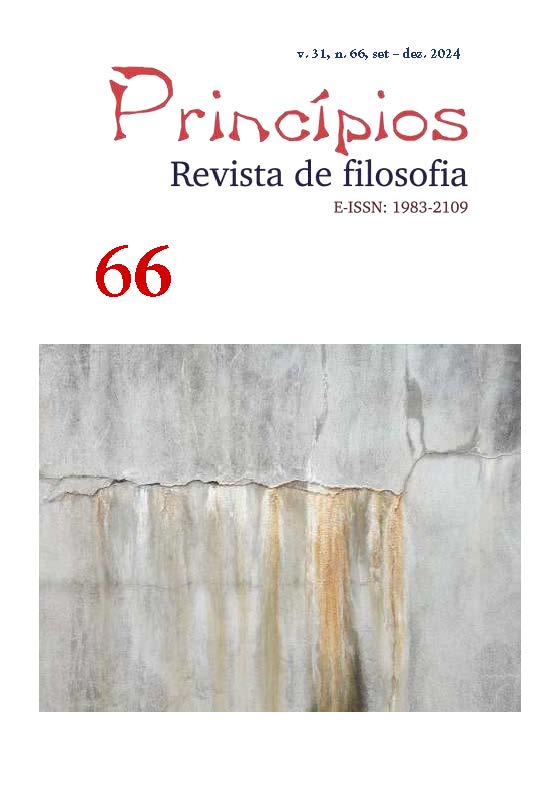Acerca da causalidade formal-final e material-eficiente na teoria da percepção de Aristóteles:
o caso da visão no livro II do De anima
DOI:
https://doi.org/10.21680/1983-2109.2024v31n66ID35646Palabras clave:
Perception; Formal-final cause; Material-efficient cause; Hylomorphism.Resumen
O objetivo desse artigo é tentar compreender como se processa a percepção visual, segundo Aristóteles. Para alcançar tal propósito, avançarei a hipótese interpretativa segundo a qual a ocorrência da visão é o resultado de uma ‘duplicidade causal’, na qual estão necessariamente envolvidos tanto fatores materiais, correspondentes à causa material-eficiente, quanto fatores ‘não-materiais’, referentes à causa formal-final. A escolha por privilegiar essa ‘duplicidade causal’ se deve ao fato que a mesma parece estar em perfeita consonância com o hilemorfismo aristotélico, algo que parece ser escamoteado tanto na interpretação ‘literalista’, quanto na ‘espiritualista’.
Descargas
Citas
AQUINO, Tomás de. Sententia de sensu et sensato. Disponível em: http://www.corpusthomisticum.org/iopera.html. Acessado em fevereiro e março de 2024.
AQUINO, Tomás de. Sententia libri de anima. Disponível em: http://www.corpusthomisticum.org/iopera.html. Acessado em fevereiro e março de 2024.
AQUINO, Tomás de. Summa theologiae. Disponível em: http://www.corpusthomisticum.org/iopera.html. Acessado em fevereiro e março de 2024.
ARISTOTLE. De Anima. Translated with an Introduction and Commentary by Chistopher Shields (Claredon Aristotle Series). Oxford: OUP, 2016.
BURNYEAT, Myles. “Aquinas on “Spiritual Change” in Perception”. In: Ancient and Medieval Theories of Intentionality. Brill, p.129–153, 2001.
BURNYEAT, Myles. “Is Aristotle’s philosophy of mind still credible?”. In: Rorty, A.O. (ed). Essays on Aristotle’s De anima. Clarendon Press. pp. 15-26, 1992.
CALLERES, Felipe. A Teoria da sensação no De anima de Aristóteles: A apreensão dos sensíveis próprios e comuns. Dissertação de Mestrado: UFSCar, 2015.
GOYETTE, John. “St. Thomas on the unity of substantial form”, Nova et vetera, English edition, vol. 7, n. 4, p. 781-90, 2009.
SORABJI, Richard. “Aristotle on Sensory Processes and Intentionality. A Reply to Myles Burnyeat”. Ancient and Medieval Theories of Intentionality. Brill, p. 49–61, 2001.
SORABJI, Richard. Body and Soul in Aristotle. Philosophy, 49, n.187, p.63-89, 1974.
TWEEDALE, Martin. “Origins of the medieval theory that sensation is an immaterial reception of a form”. Philosophical Topics, vol. 20, n. 2, p. 215-231, 1992.
Descargas
Publicado
Cómo citar
Número
Sección
Licencia
Derechos de autor 2024 William Teixeira

Esta obra está bajo una licencia internacional Creative Commons Atribución-NoComercial-CompartirIgual 4.0.
Autores mantêm os direitos autorais e concedem à revista o direito de primeira publicação, com o trabalho simultaneamente licenciado sob a Licença Creative Commons Attribution que permite o compartilhamento do trabalho com reconhecimento da autoria e publicação inicial nesta revista.
Termos da licença:
| Não Comercial (NC) | Os licenciados podem copiar, distribuir, exibir e executar a obra e fazer trabalhos derivados dela, desde que sejam para fins não comerciais. |
| Compartilha Igual (SA) | Os licenciados devem distribuir obras derivadas somente sob uma licença idêntica à que governa a obra original ou menos restritiva. |


 Português (Brasil)
Português (Brasil) English
English Español (España)
Español (España) Français (Canada)
Français (Canada)


